Instantaneous electric water heater for tap: tips for choosing + review of the best brands
To quickly solve problems with hot water supply, a technical device has been created - an electric instantaneous water heater for a tap. This device, useful in everyday life, differs from its predecessors in its affordable cost, compactness and ease of installation.
The effectiveness of the device will be appreciated if its technical characteristics meet the needs of the user and operating conditions.
The content of the article:
The feasibility of using a heated tap
An instantaneous water heater for a tap is the most compact electrical appliance that provides hot water supply. The feasibility of using a compact device depends on the intensity and operating conditions.
To decide whether a mini-heater is suitable for your own needs, you should compare the pros and cons.
The main advantages of a compact water heater for taps:
- Compactness. This argument becomes decisive for small spaces. The heater takes up the space reserved for the faucet for installation on a bathroom sink, kitchen sink or countertop.
- Heating rate. Depending on the power of the model, the time to warm up to a comfortable temperature ranges from 10-30 seconds.Can't boast of this quality storage water heaters – the boiler must be turned on in advance, at least 30 minutes before use.
- Consistency of temperature. In technically advanced heaters, the heating process is monitored by electric sensors that regulate the incandescence level of the heating element.
- Aesthetics. The diversity of the model range allows you to choose a water heating faucet to suit a specific interior style. Manufacturers offer specimens of different colors with a glossy or matte effect, unusual spout shapes and valves with original geometry.
- Easy to install. The technology is almost identical to installing a conventional tap. The difference lies in the need for power supply and grounding of the device.
- High efficiency. The thermo-faucet functions after the fact - it only heats up while using the mixer. In a state of "rest" electricity is not consumed.
The advantage of a small-sized module is its cost. The price of a water heating faucet is less than that of a full-size electric or gas flower, especially for a storage boiler.
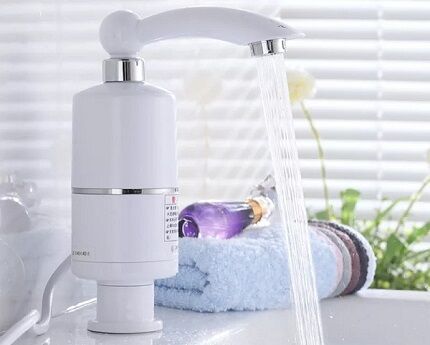
However, manufacturers of flow-through devices claim that their devices are economical, focusing on energy consumption exclusively when using water. While the storage boiler operates in the mode of maintaining the set temperature - the unit comes into operation every 20-30 minutes.

Additional disadvantages of a water heater for a tap:
- Limited bandwidth. The volume of heated water is 4-6 l/min. For comparison, the productivity of a gas water heater is approximately 1.5-2 times higher.
- High network load. Installing a duct in a building with old wiring requires a separate cable. Regardless of the state of the electrical network, the flow generator must be connected through a reinforced socket connected to the RCD.
- Maintenance of one water intake point. It is impossible to divide the incoming volume of heated water into several streams. To organize hot water supply to several points, it is better to purchase a storage heater or a wall flower.
- Difficulty of repair. In the event of a breakdown, restoring the functionality of a portable module is problematic - in the retail chain, repair kits for such models are an order of magnitude smaller than for a wall-mounted electric heater.
Thinking about a purchase shower drain or for a kitchen faucet, it should be noted that low-power appliances can increase the water temperature by 25°. This indicator is sufficient in the warm season. With the onset of cold weather, with a significant decrease in the temperature of tap water, it is unrealistic to obtain the desired 35-40°C.
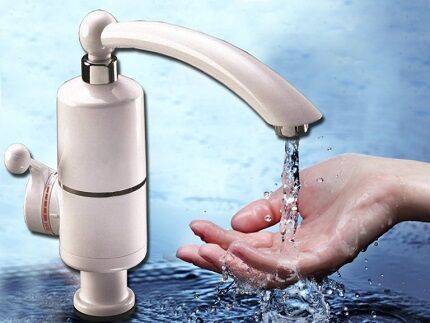
Despite the indicated disadvantages, it is advisable to install mini-heaters in the following situations:
- instability of centralized hot water supply, when interruptions in the network are short-term - no more than a month;
- seasonal water consumption is typical for country houses and country cottages;
- organization of water supply in the summer kitchen of a private household;
- in hairdressing salons, beauty salons;
- in kitchens in buildings with individual gas heating - it is not profitable to turn on the boiler for washing dishes.
In a word, installing a heated tap is completely justified if hot water supply is not required constantly and in a limited volume.
Features of the device and operation of the “flow-through”
The miniature water heater is similar in appearance to regular mixer, a distinctive feature is increased dimensions. The heat-resistant casing contains a water heating element and a lot of equipment responsible for the safe operation of the thermal nozzle.

Inside the module there is a cartridge mechanism for regulating water flow and a reservoir with a powerful electric heater. It is the small internal volume of the tank and the high power of the heating element that explains the heater’s ability to reach the desired temperature in a matter of seconds.
The operating principle is extremely simple. Water enters the heating cylinder, comes into contact with the heated coil and, already heated, is supplied to the mixer spout.
The design of an instantaneous electric water heater for a tap provides a so-called “safety group”.
The complex includes the following elements:
- Pressure sensor. Turns off the heating element if network pressure does not exceed 0.004 MPa and blocks the operation of the module when the value increases above 0.7 MPa.Excessive pressure is dangerous for internal elements.
- Flow sensor and thermostat. Provide protection for the tubular electric heater from combustion when the water supply is stopped. In addition, the flow sensor is responsible for instant heating after opening the tap.
- Automatic fuse. In the event of a surge in mains voltage above normal or a short circuit inside the module, the current supply is stopped.
Most flow machines are equipped with protection against water hammer - the device body contains elastic plastic and a silicone damper.
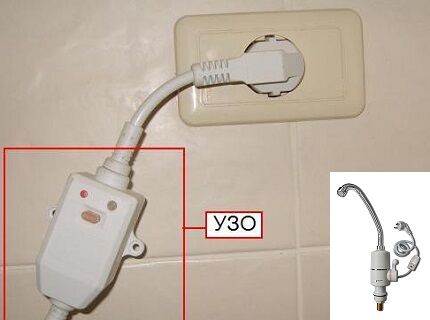
Types of compact electric heaters
Hot water supply modules for faucets are usually divided into two types: a removable heating nozzle and faucets with a built-in heating element. To supply warm water to the sink of the wash area and to the kitchen sink, universal wall outlets are often used.
Separate faucet attachment
The module is installed on the spout of a previously installed mixer. The main advantages of the mini-block: low cost, ability to connect to an existing tap, compactness. The disadvantages are obvious - as a rule, the thermo-block has low power and productivity (about 4 l/min).
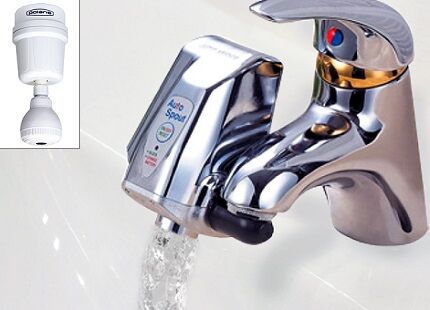
As a protective element, the module is equipped with a temperature sensor that prevents overheating of the internal elements.
Instant water heating mixer
Heated taps occupy a large part of the segment of instantaneous miniature water heating units.The device operates in three modes:
- Hot water supply. The mixer handle is turned to the right. The electrical system comes into operation, providing a flow of warm water.
- Cold water supply. Turning the lever to the left turns off the electrical part of the faucet - cold water flows from the mixer.
- Shutdown. The joystick handle is in the central lowered position - the heating tap is inactive. The circuit is de-energized and the water supply has been stopped.
In most flow-type models, the water temperature is controlled by changing the pressure. Moving the lever vertically allows you to select the heating mode with an error of 0.5-1°C.

Wall-mounted “flow outlet”: pressure and non-pressure model
A universal water heater can be connected to the tap.
The electrical module has a number of distinctive features:
- the ability to service several water intake points simultaneously;
- high degree of protection;
- productivity up to 7-9 l/min, which is more in comparison with faucet attachments and mixer-heaters;
- wall mounting.
The body is made in the form of a spacious box. The increased area of the heating element explains the improved heating characteristics of the device.
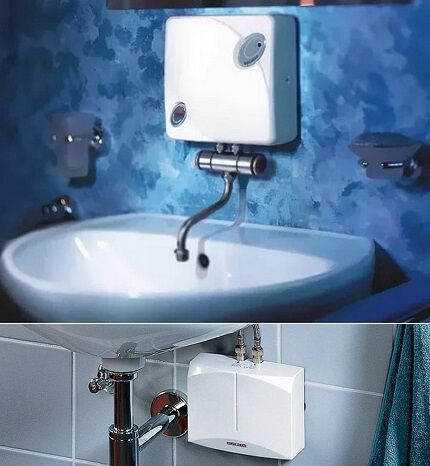
There are two types of wall ducts:
- Pressure. Hot water from the heater is supplied to the distribution network, and then to the water intake points. The power of the units is 3-20 kW, single- and three-phase connection is possible.
- Non-pressure. Designed to serve one point of water consumption - water from the mini-boiler is immediately transferred outside through the tap. Device power is 2-8 kW.
With a sharp fall pressure in the water supply system the flow of water through the gravity module will slow down - there is a high probability of obtaining very hot water at the outlet. In devices with a temperature sensor, this problem is solved.
Criteria for choosing an electric heater for a tap
Having decided on the type of device, you should calculate the appropriate power of the module and compare the technical and operational characteristics of different models.
Unit power and performance
When choosing a flow generator, its power indicator plays a decisive role. The required value is determined based on the priority purposes of use: kitchen sink, bathroom sink, etc.
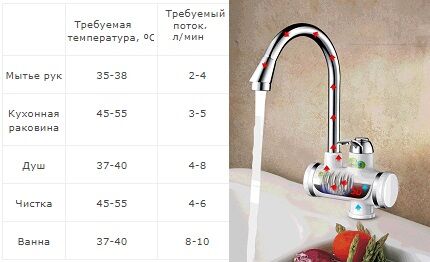
Power is determined by the formula:
W=V*(T2-T1)/14.3, Where:
- W – design power of the portable heater, kW;
- V – water consumption or unit productivity, l/min;
- T2 – desired temperature, depending on needs, C°;
- T1 – tap water temperature (summer value – about 15°С, winter – about 5°С);
- 14.3 is a constant.
If simultaneous consumption from several water points is planned, then the final figure increases by 1.5 times.
Calculation example. You need to select a flower for the kitchen sink; the optimal temperature for use is 45°C. Based on the table, a model with a capacity of 4 l/min is suitable for washing dishes.For objective calculation, it is better to use the average annual water temperature in the main - about 10°C.
W=4*(45-10)/14.3=9.79 kW.
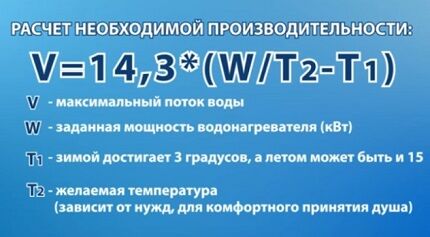
Having selected the power of the heater, an important question arises: is the electrical wiring sufficient? In old buildings with 16 A plugs, you cannot install a flow generator of more than 3.5 kW. New houses with meters of 32 A and 40 A will “pull” a water heater up to 6 kW.
Heating element type
The heart of the flow module is the heating element. In the classic design, the heating element is assembled in the form of a spiral to increase the water contact area.

In addition to the spiral shape, the heating element can be made as a curved or straight tube with an electric heater enclosed inside. Water circulates through the coil. Closed heating elements cope better with scale formation.
The efficiency and durability of the heating element is largely determined by the material it is made of.
Possible options:
- Heating elements with a copper or anodized shell - provide good heat transfer and protection against scale;
- ceramic tubular heater – highly efficient, durable and expensive;
- spiral blocks protected by glass belong to the premium segment, do not require maintenance, and when scale forms, they partially change the rate of heat transfer.
Spiral induction heat exchangers are considered the most technologically advanced solution.In addition to providing effective heating, eddy currents cause the central core to vibrate. This effect is the prevention of scale formation.
Electrical safety level of the device
In addition to the presence of built-in “protection group” elements, the outer shell must also comply with safety standards.
You should pay attention to two indicators:
- class of protection of an electrical device against electric shock;
- IP index - marking the protection of the housing from external influences.
The protection class displays the requirements for connecting the heating module and how to prevent electric shock. A instantaneous water heater is characterized by protection class - 1. Safety is ensured by mandatory grounding of conductive parts and basic insulation.
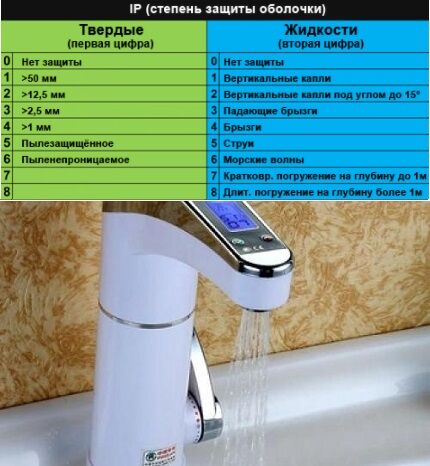
Taking into account additional parameters
In addition to the listed characteristics, when choosing a hot water supply module, you should consider:
- control method;
- case material;
- secondary functionality.
The entire variety of flow generators is divided into mechanical and electronic units. The first are otherwise called hydraulic. The mechanics are typical for budget class modules and mid-price segment devices.
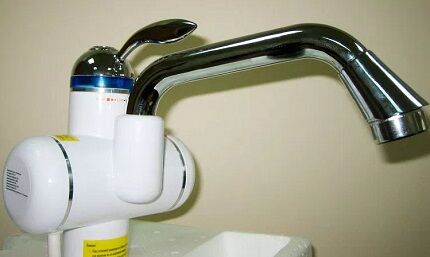
Disadvantages of the method: the impossibility of fine-tuning the temperature regime and saving the selected parameters.The electronic mechanism, using sensors and microprocessors, independently maintains the specified settings, adjusting the operating mode to the current network pressure and temperature.
The product is regularly exposed to high temperatures and the chemical composition of the passing liquid. Therefore, the housing must have heat resistance and sufficient strength. Enameled, polypropylene and copper “shells” have proven themselves well - the materials are resistant to aggressive environments and temperature changes.
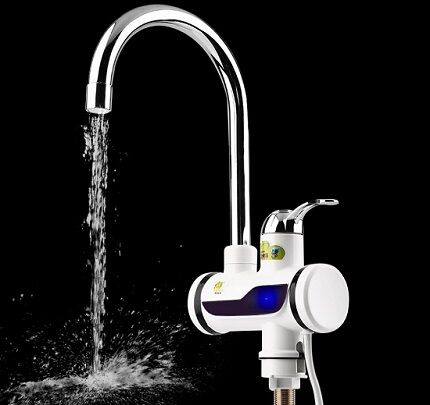
Some built-in secondary functionality ensures comfortable use of the water heating tap.
Useful options include:
- the presence of an informative display and operating mode indication;
- heating and cooling temperature limitation;
- programming capability;
- work with different power;
- color lighting.
Also, some manufacturers have equipped their products with a practical function - child locking of the heater.
Review of branded models
Water heating taps from well-known brands are in particular demand:
- Delimano (Ukraine/Italy);
- Supretto (China);
- Aquatherm (Russia);
- Rapid (China).
Delimano. The company offers the Aquasystem instant water heater. The module is presented in the form of a cylindrical block with a faucet-regulator and spout.

Distinctive features of "Aquasitem":
- fast heating up to +60°C;
- presence of a temperature regulator;
- indicator light;
- connecting the cord from the back of the case;
- warranty – 365 days;
- Estimated cost – 25-30 USD
Supretto. The faucet is made of heat-resistant high-strength plastic, the internal elements are metal. The device is equipped with the necessary safety system - the design includes grounding and protection against overheating.

There is an indicator on the front wall of the case, the control lever is located on the side. The cost of a miniature electrical appliance is about 30 USD.
Aquatherm. Single lever heating tap of Russian assembly. Features a high arched spout, a water filter and plastic aerator with the "Anti-Calcium" option.
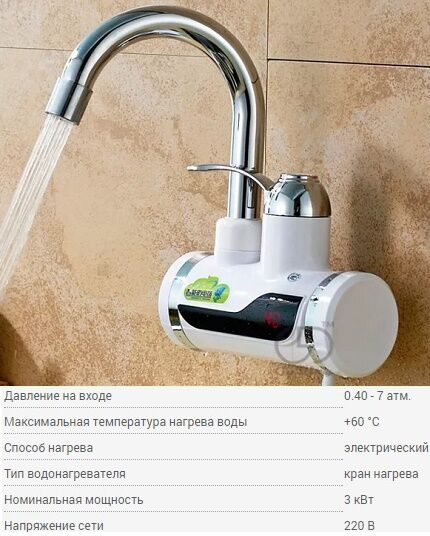
The model is available in 4 colors: blue, burgundy, white, beige. Issue price – 50 USD
Rapid. Branded water heaters have multi-level protection. In economy models, the temperature is controlled using a joystick lever. In more expensive options, the heating mode is controlled by an electronic sensor.
Features of Rapid flow faucet modules:
- Heating element made of heat-resistant polymer;
- the heating ceramic disk can operate continuously for up to 5000 hours;
- heating temperature – 30-60°C;
- grounding of the main body.
In all models, the heating elements are protected by an insulating layer.
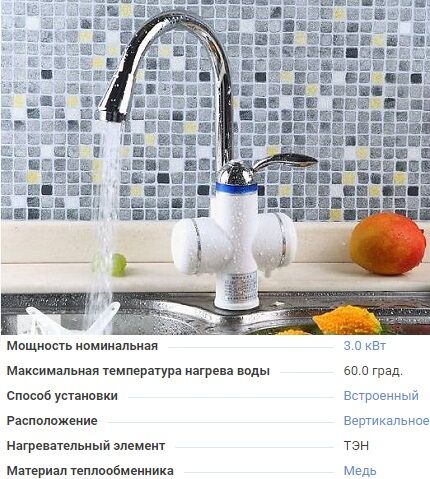
Among wall-mounted flow ducts, the following models are popular: Kospel, Electrolux, AEG, Bosh, Termex.
Conclusions and useful video on the topic
To summarize and generalize the stated theory, we present visual video reviews about the installation, practicality and efficiency of thermal taps.
Step-by-step installation and testing of the Delimano heater:
Test drive of a Rapid heated mixer, assessment of heating speed:
In some situations, a water heating tap is the optimal and only possible option for organizing hot water supply. In order not to make a mistake in your choice, you should realistically assess your own needs and calculate the required power. Important purchase criteria are the safety of the device and the reputation of the manufacturer.
Please write comments in the block below. Tell us about how the faucet with water heater works in your home or country house. Ask questions, share useful information with site visitors, post photos related to the topic of the article.




And I used to be prejudiced against these instantaneous mini-water heaters. And now I read the article more carefully, but still did not imagine the real situation when they are needed. The only cases where rolling outages of hot water systematically occur, but even then you need to take a boiler, and not this toy. Disadvantages for me: the need for a separate power supply, a separate RCD, not very aesthetically pleasing, extra charges for electricity. I didn't see any advantages.
Each thing has its own niche. Not everyone can afford to buy a boiler for their summer cottage. And there is very little warm water for them. It is in such a situation that this flow-through heater is applicable. Its cost, compared to a boiler, is simply ridiculous. Connecting is no more difficult than a regular mixer.
In the cold season, such a device on the tap has become a real salvation. The water is very cold and the dishes have to be washed every day. We installed a special water heating nozzle. Now I can’t get enough of it, I open the tap and hot water comes out of it. Perfect for those who have intermittent hot water supplies. It is compact, does not take up much space, looks nice, and does not spoil the overall design of the kitchen.
And think of making such a faucet but with a weak hot and cold water supply? This is exactly what you need for the period when hot water is turned off. But it makes no sense. Are engineers' brains really not working? If it’s hot, it works as a mixer; if not, it heats for two weeks. Is it really that difficult to implement?
I have a mixer like the one in the video at my dacha. We bought it on Ali Express about 5 years ago. An excellent option for a summer residence. The outlet is nearby. I even wash my hair under this tap.